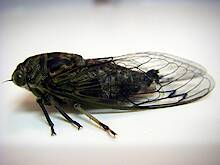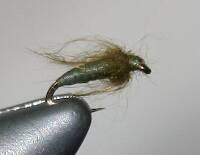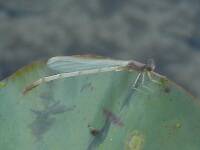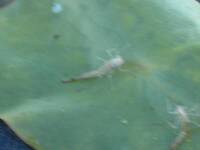
Salmonflies
Pteronarcys californica
The giant Salmonflies of the Western mountains are legendary for their proclivity to elicit consistent dry-fly action and ferocious strikes.
Featured on the forum

This specimen keys pretty easily to Onocosmoecus, and it closely resembles a specimen from Alaska which caddis expert Dave Ruiter recognized as this genus. As with that specimen, the only species in the genus documented in this area is Onocosmoecus unicolor, but Dave suggested for that specimen that there might be multiple not-yet-distinguished species under the unicolor umbrella and it would be best to stick with the genus-level ID. I'm doing the same for this one.

Troutnut is a project started in 2003 by salmonid ecologist Jason "Troutnut" Neuswanger to help anglers and
fly tyers unabashedly embrace the entomological side of the sport. Learn more about Troutnut or
support the project for an enhanced experience here.
By Troutnut on March 31st, 2016, 2:02 am EDT
Where do you need to put the fly to catch a trout?
Countless books about fly fishing contain whole chapters on this subject, but a couple of the main lessons are (1) get the fly down to the fish's level, if you're fishing subsurface, and (2) cast upstream of the fish, not right over its head.
Thanks to the hard work of my labmates at the University of Georgia building detailed datasets for the Drift Model Project, I was able to construct some 3-D animation videos showing where drift-feeding fish, such as trout, detect their prey. We're using these data to test models that predict how much energy the fish are gaining and how that depends on aspects of their habitat such as water velocity and drifting prey. Those models will eventually help us better predict the effects of habitat modifications and changing streamflow patterns on trout and other drift-feeding fish. We're far from done crunching all the numbers from last summer's data collection, but some of our intermediate results may be interesting to fly anglers.
A few key videos are embedded below, but the full set is available as a playlist on the Drift Model Project's Youtube channel.
The videos rotate around an animated fish representing either an Arctic grayling (14-19 inches long), dolly varden (6-8 inches long), or juvenile Chinook salmon (about 3 inches long). The yellow dots show the estimated positions of potential prey items (some real prey, some inedible debris) at the moment when the fish reacted to them. All the positions are shown relative to the position of the fish, which is shown facing straight upstream.
Here's one from a smallish (~14-inch) Arctic grayling during a moderately thick Cinygmula hatch:
Note the separate layer of detection positions on the top, all of which were prey taken from the water's surface (not quite in an even plane because of small measurement errors). Some goes for the following 19-inch grayling feeding during a Drunella doddsii hatch:
And here's a 7-inch dolly varden feeding without any particular hatch:
And a juvenile Chinook salmon:
Obviously this is a limited sample. We're continually expanding it, but even then we're only studying three species at the moment. So don't be surprised if you've seen some things that don't fit these patterns. Nevertheless, they give me reason to speculate a few possible insights into fly fishing:
First, the fish react most often to subsurface prey that drift really close to them. So there's probably a huge payoff for very accurate fly placement, especially when you're sight fishing with a subsurface fly. Getting down to the fish's level is clearly critical, but so is placing the fly laterally so it passes right by the fish.
Second, even though the grayling were surface feeding on hatches, they continued to take a lot more subsurface prey throughout the time we observed them. These fish seemed to be picky about what they took from the surface, judging by what flies they would accept when we caught them later to (harmlessly) pump their stomachs. Yet despite that apparent selectivity on the surface, they were pursuing and capturing a variety of items below the surface. Nymph aficionados, some of whom prefer to fish a nymph straight through a hatch and a good rise of fish, may rejoice at this news. But not so fast, because...
Third, the fish react to prey on the surface from much farther away than they react to subsurface prey, perhaps because it better stands out against the background. This explains why dry flies work so well, and it offers the dry fly angler a defense against the nympher who insists that it's better to fish subsurface because that's where the fish get most of their food. It's true that there's rarely a better way to entice a fish than to present a nymph on a perfect, accurate drift. But it can take most of us several tries to get that perfect subsurface presentation, especially if we don't know exactly where the fish is. When trying to just read the water and guess where fish might be, it makes a lot of sense to use a dry, because every cast effectively covers a lot more ground. Even when we're working a particular rising fish that would be receptive to a nymph or dry, it's easier to consistently cast a dry into the strike zone than a nymph.
Finally, I want to emphasize again that these are just my preliminary thoughts as an angler after seeing the data we've analyzed so far on this project. They are not conclusive scientific findings. But they are good food for thought.
Countless books about fly fishing contain whole chapters on this subject, but a couple of the main lessons are (1) get the fly down to the fish's level, if you're fishing subsurface, and (2) cast upstream of the fish, not right over its head.
Thanks to the hard work of my labmates at the University of Georgia building detailed datasets for the Drift Model Project, I was able to construct some 3-D animation videos showing where drift-feeding fish, such as trout, detect their prey. We're using these data to test models that predict how much energy the fish are gaining and how that depends on aspects of their habitat such as water velocity and drifting prey. Those models will eventually help us better predict the effects of habitat modifications and changing streamflow patterns on trout and other drift-feeding fish. We're far from done crunching all the numbers from last summer's data collection, but some of our intermediate results may be interesting to fly anglers.
A few key videos are embedded below, but the full set is available as a playlist on the Drift Model Project's Youtube channel.
The videos rotate around an animated fish representing either an Arctic grayling (14-19 inches long), dolly varden (6-8 inches long), or juvenile Chinook salmon (about 3 inches long). The yellow dots show the estimated positions of potential prey items (some real prey, some inedible debris) at the moment when the fish reacted to them. All the positions are shown relative to the position of the fish, which is shown facing straight upstream.
Here's one from a smallish (~14-inch) Arctic grayling during a moderately thick Cinygmula hatch:
Note the separate layer of detection positions on the top, all of which were prey taken from the water's surface (not quite in an even plane because of small measurement errors). Some goes for the following 19-inch grayling feeding during a Drunella doddsii hatch:
And here's a 7-inch dolly varden feeding without any particular hatch:
And a juvenile Chinook salmon:
Obviously this is a limited sample. We're continually expanding it, but even then we're only studying three species at the moment. So don't be surprised if you've seen some things that don't fit these patterns. Nevertheless, they give me reason to speculate a few possible insights into fly fishing:
First, the fish react most often to subsurface prey that drift really close to them. So there's probably a huge payoff for very accurate fly placement, especially when you're sight fishing with a subsurface fly. Getting down to the fish's level is clearly critical, but so is placing the fly laterally so it passes right by the fish.
Second, even though the grayling were surface feeding on hatches, they continued to take a lot more subsurface prey throughout the time we observed them. These fish seemed to be picky about what they took from the surface, judging by what flies they would accept when we caught them later to (harmlessly) pump their stomachs. Yet despite that apparent selectivity on the surface, they were pursuing and capturing a variety of items below the surface. Nymph aficionados, some of whom prefer to fish a nymph straight through a hatch and a good rise of fish, may rejoice at this news. But not so fast, because...
Third, the fish react to prey on the surface from much farther away than they react to subsurface prey, perhaps because it better stands out against the background. This explains why dry flies work so well, and it offers the dry fly angler a defense against the nympher who insists that it's better to fish subsurface because that's where the fish get most of their food. It's true that there's rarely a better way to entice a fish than to present a nymph on a perfect, accurate drift. But it can take most of us several tries to get that perfect subsurface presentation, especially if we don't know exactly where the fish is. When trying to just read the water and guess where fish might be, it makes a lot of sense to use a dry, because every cast effectively covers a lot more ground. Even when we're working a particular rising fish that would be receptive to a nymph or dry, it's easier to consistently cast a dry into the strike zone than a nymph.
Finally, I want to emphasize again that these are just my preliminary thoughts as an angler after seeing the data we've analyzed so far on this project. They are not conclusive scientific findings. But they are good food for thought.
Comments / replies
Crepuscular on Mar 31, 2016March 31st, 2016, 10:58 am EDT
Nice Jason. I have a couple questions and maybe that's because my reading comprehension sucks.
First, what do you mean by the fish "reacted" to a prey item? Does that mean the fish actively attempted to eat, or some other reaction?
Second, How far away is the distance to the most distant prey item? I don't have a good take on the distance scale.
First, what do you mean by the fish "reacted" to a prey item? Does that mean the fish actively attempted to eat, or some other reaction?
Second, How far away is the distance to the most distant prey item? I don't have a good take on the distance scale.
Troutnut on Mar 31, 2016March 31st, 2016, 12:25 pm EDT
First, what do you mean by the fish "reacted" to a prey item?
The yellow dots represent the estimated position of each prey item at the moment when the fish first began moving toward it, i.e. "reacted" to it. This is assumed to be an estimate of where the fish first detected the item, too.
It's different from the position at which the fish actually caught the item.
The distance scales are relative to the sizes of the fish, which are stated in the post, but ballpark I'd say the grayling were detecting things within 1-2 feet subsurface and about 3-5 feet on the surface, dollies mostly within a foot, and juvenile Chinook mostly within six inches.
Jason Neuswanger, Ph.D.
Troutnut and salmonid ecologist
Troutnut and salmonid ecologist
Entoman on Mar 31, 2016March 31st, 2016, 12:36 pm EDT
Fascinating!
"It's not that I find fishing so important, it's just that I find all other endeavors of Man equally unimportant... And not nearly as much fun!" Robert Traver, Anatomy of a Fisherman
Jmd123 on Mar 31, 2016March 31st, 2016, 2:26 pm EDT
AHA, at long last an explanation as to why I so much prefer dry flies to nymphs! Of course, it is also due to a lack of expertise with nymphs that many others on here possess...but having tried nymphing on many an occasion, especially earlier in my formative years, I just always had more success with dries, hatch or no hatch. My default behavior on a quiet-looking stretch of water is to search with an elkhair caddis, or sometimes an Adams, and it is amazing how many fish will hit out of nowhere under those conditions. Now it makes sense!
Jonathon
Jonathon
No matter how big the one you just caught is, there's always a bigger one out there somewhere...
DayTripper on Mar 31, 2016March 31st, 2016, 4:07 pm EDT
Bravo, love it. Thanks for sharing. Definitely thought provoking.
TimCat on Mar 31, 2016March 31st, 2016, 6:22 pm EDT
Very nice. Your preliminary conclusions are a good read. Looking forward to more of you and your team's analysis! I've never seen any studies like this at all.
It's interesting to see that even though there was "a moderately thick Cinygmula hatch", the grayling still mostly went for food directly in front of it. It wasn't really looking up much, although it was eager to move further when it did.
Another reason that the surface targets may have not been on an even plane, could be due to the fact that the insect was emerging still (?). As many have experienced, soft hackle patterns at the end of a drift seem to get some harder strikes. It's always been assumed that emerging insects in their shucks, or while they're trying to get above the surface tension, attract their attention more. Just a thought.
Thanks for sharing! I think this is pretty innovative stuff, although I am not part of any biology communities. Ha
It's interesting to see that even though there was "a moderately thick Cinygmula hatch", the grayling still mostly went for food directly in front of it. It wasn't really looking up much, although it was eager to move further when it did.
Another reason that the surface targets may have not been on an even plane, could be due to the fact that the insect was emerging still (?). As many have experienced, soft hackle patterns at the end of a drift seem to get some harder strikes. It's always been assumed that emerging insects in their shucks, or while they're trying to get above the surface tension, attract their attention more. Just a thought.
Thanks for sharing! I think this is pretty innovative stuff, although I am not part of any biology communities. Ha
"If I'm not going to catch anything, then I 'd rather not catch anything on flies" - Bob Lawless
Crepuscular on Mar 31, 2016March 31st, 2016, 7:06 pm EDT
Thanks Jason really cool stuff.
See I told you about my reading skills...
The distance scales are relative to the sizes of the fish, which are stated in the post
See I told you about my reading skills...
Jmd123 on Apr 1, 2016April 1st, 2016, 9:27 pm EDT
So I do see a difference between fish species here a little bit, but then again it could be the sample size and perhaps these fish had individual, idiosyncratic behavior...? Raises a lot of interesting questions, no end for research...how do brookies, browns, rainbows, cutthroats compare? Larger vs. smaller fish, stillwater fish vs. stream fish...looks like you'll need some grad students to help you with all of the projects, Jason!
Jonathon
Jonathon
No matter how big the one you just caught is, there's always a bigger one out there somewhere...
Wbranch on Apr 2, 2016April 2nd, 2016, 4:17 am EDT
Thanks for sharing this with us. Your observations and comments suggest that employing a dry & dropper setup could increase an angler's chances for a take and success.
While I seldom run a dry & dropper on the Delaware system (I'm more inclined to run two dry flies there, either two identical or the first fly larger and tail fly much smaller. Then the larger fly acts as an indicator for me)
In Montana I run a dry and dropper at least 75% of the time with the length of the tippet for the tail fly as long as 3' depending on the water depth. Most of the time though the tippet length is less than 12" because I'm only casting to rising fish but if it is very windy I often can't get the fly where I want it but the little BH nymph gets into the water column high enough that the trout often eats it.
While I seldom run a dry & dropper on the Delaware system (I'm more inclined to run two dry flies there, either two identical or the first fly larger and tail fly much smaller. Then the larger fly acts as an indicator for me)
In Montana I run a dry and dropper at least 75% of the time with the length of the tippet for the tail fly as long as 3' depending on the water depth. Most of the time though the tippet length is less than 12" because I'm only casting to rising fish but if it is very windy I often can't get the fly where I want it but the little BH nymph gets into the water column high enough that the trout often eats it.
Catskill fly fisher for fifty-five years.
Jmd123 on Apr 2, 2016April 2nd, 2016, 9:45 am EDT
OK Matt, a question for you (and others): when fishing a dry and dropper rig, which fly do the fish hit more often, the dry or the dropper? I've never tried a two-fly rig but I keep seeing how popular it is with a lot of fisherman. Makes sense that your "indicator" is an actual fly that the fish can also get hooked on!
Jonathon
Jonathon
No matter how big the one you just caught is, there's always a bigger one out there somewhere...
Wbranch on Apr 2, 2016April 2nd, 2016, 9:51 pm EDT
Jonathon,
Firstly I need to edit my comment about "I run a dropper at least 75% of the time" (in Montana) I've thought more about this and I'd say my use of a dropper with a dry is no more than 50% of the time. I've never kept an accurate count of how many fish I catch on the dropper versus the dry fly but I'd guess it is about 50/50.
Firstly I need to edit my comment about "I run a dropper at least 75% of the time" (in Montana) I've thought more about this and I'd say my use of a dropper with a dry is no more than 50% of the time. I've never kept an accurate count of how many fish I catch on the dropper versus the dry fly but I'd guess it is about 50/50.
Catskill fly fisher for fifty-five years.
TimCat on Apr 3, 2016April 3rd, 2016, 12:59 am EDT
Jonathon,
I've read that the dry part of the rig can also work as an attractor and be useful, even if the fish don't go for it most of the time. The fish notices the surface fly, but will often take the nymph instead.
I've also heard Tom Rosenbauer talk about this on the orvis podcast I think. I've never personally tried it either, though it can kinda be supported by the animations in a way. The surface activity could bring a fish from further away, but they might go for the easy nymph instead, because it definitely can't fly away/is the easier meal.
I've read that the dry part of the rig can also work as an attractor and be useful, even if the fish don't go for it most of the time. The fish notices the surface fly, but will often take the nymph instead.
I've also heard Tom Rosenbauer talk about this on the orvis podcast I think. I've never personally tried it either, though it can kinda be supported by the animations in a way. The surface activity could bring a fish from further away, but they might go for the easy nymph instead, because it definitely can't fly away/is the easier meal.
"If I'm not going to catch anything, then I 'd rather not catch anything on flies" - Bob Lawless
Quick Reply
Related Discussions
Topic
Replies
Last Reply
11
Oct 5, 2015
by Planettrout
by Planettrout
1
Mar 9, 2012
by Wiflyfisher
by Wiflyfisher
13
Sep 23, 2017
by Martinlf
by Martinlf
1
Jul 11, 2008
by Taxon
by Taxon











